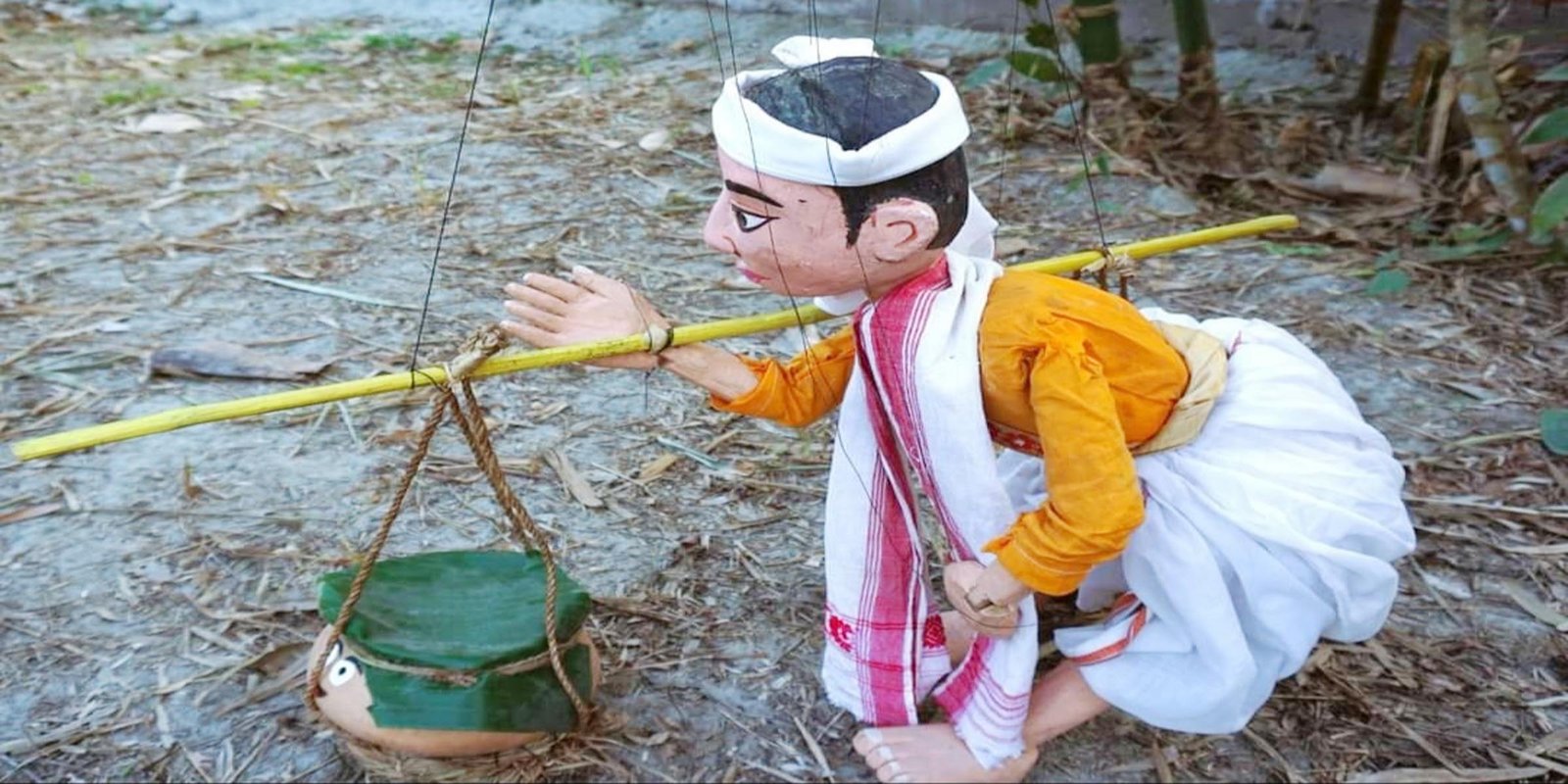By: Simanta Sarma
The puppet dance artists Tripura’s Prabhitangshu Das and Assam’s Binita Devi have attracted the younger generation of the North-Eastern region towards puppetry and are engaging them in the path of earning. Puppet dances of the North-Eastern region have gained recognition worldwide.
The North-Eastern region of India comprises the states of Assam, Meghalaya, Arunachal Pradesh, Nagaland, Manipur, and Tripura, forming the northeastern part of India. Although these seven states share historical and geographical aspects, their cultural diversity is notable. In prehistoric and historic times, this region was known as Pragjyotisha, and after India’s independence, due to political, economic, and other reasons, Assam was divided into seven states.
Despite the political division, the traditional society and culture of these seven states are deeply interconnected. Puppetry, especially puppet dance, is a significant aspect of the cultural presentation in the North-Eastern region. Traditional puppetry or puppet theater combines elements of song, dance, and drama. Dialogues in traditional puppet theater are minimal, and emphasis is placed on poetic verses. Songs hold greater importance in traditional puppet theater as they often conclude the performance or act as the climax. Oral tradition is prevalent in Puppet Theater, and stories are usually based on epics like Ramayana, Mahabharata, or Puranas. Puppet theater often incorporates humorous elements to depict various situations from real life with a touch of satire.
The art of making clay Puppets in Assam, Tripura, and Manipur is visibly similar. Puppets are crafted from the clay obtained from local riverside soil. Artists of puppet nachs (dance) use their expressions as a means of communication in their mother tongue. Before the performance of puppet dances, the tradition of worshiping Bhagavata (a form of god) is a common characteristic of the traditional Suta Putala dance of the northeastern region. Puppets are revered with great respect, and the leader or patron of the group is often worshiped in their homes with devotion. Puja (ritual worship) is performed with burning incense sticks and oil lamps during the night on auspicious occasions. Puppets are crafted to represent various forms of gods during these rituals.
Top of Form
The attire and decorations of the clay puppets in Manipur are influenced by the traditional Ras Leela dance dramas. In Assam, during the narration of myths and epics, the puppets are adorned to depict various characters and scenes, and in Tripura, the puppets are adorned with attire and decorations through the journey of puppetry. Since all aspects of puppetry in the North-Eastern region are interconnected with the artisans’ social life, lifestyle, puppet-making process, selection of themes, and presentation style, similarities are observed. Therefore, the current generation is analysing various social issues through this common perspective. The majority of puppeteers in the Northeastern region is uneducated villagers.
Consequently, there is a lack of capacity stemming from a dearth of exposure to the present environment. However, it must be acknowledged that despite this, puppeteers excel in the craft of puppet making and have considerable expertise in presentation. It is true that the promotion of folk art contributes significantly to the preservation of cultural heritage, and it offers ample opportunities for innovation and advancement. In this regard, I can provide an example of the contemporary puppetry group from the Northeastern region. Contemporary puppetry groups in this region have achieved notable success in various challenging tasks.
Puppeteer artists from Tripura, Prabhitangshu Das (Eminent Puppeteer and Sangeet Natak Akademi Awardee), and Assam’s Binita Devi (Eminent Puppeteer, Actress and National Tagore Research Scholarship From Ministry of Culture, Govt of India) are attracting young generations in the Northeastern region towards puppetry and engaging them in the path of earning. Puppetry in the Northeastern region has gained recognition worldwide. Tripura Puppet Theatre and Assam’s Surojit Academy are making efforts to give puppetry a commercial form. Artists associated with contemporary puppetry have received formal training in various fields like fine arts, drama, etc., and they are educated urban youths. Every day, all these artists spend 3-4 hours creating puppetry artworks.
Despite reduced attendance at puppet shows, puppeteers can earn around 60-70 thousand rupees per year. Puppetry artist Prabhitangshu Das has organized events even in Germany in 2012. Binita Devi from Guwahati has significantly contributed to the promotion and dissemination of puppetry art in Northeastern India. She has received a national scholarship from the Ministry of Culture, Government of India, and is conducting research at Mahapurusha Srimanta Sankaradeva Viswavidyalaya. She is providing puppetry training to individuals and organizations like National Council of Educational Research and Training, Centre for Cultural Resources and Training (CCRT), Assam Science Technology and environment Council, Vigyan Prasar, State Council of Educational Research and Training (SCERT) and various universities and colleges. This field of artistic education is considered important by the Government of India. Presenting puppetry in the context of contemporary surroundings has added a special dimension to educational aspects.
Contemporary puppetry is now being sought after in society’s contemporary sphere. In this regard, Prabhitangshu Das and Binita Devi have attracted non-artistic youth from the Northeastern region. Many educated young people are showing interest in this art form. Many have received national scholarships from the Ministry of Culture, Government of India, and have received fellowships and scholarships at the national level.
The traditional puppet dance of Tripura is known as “Putul Nach.” In Assam, it is also called “Putala Nach.” The process of making clay puppets is similar in Assam and Tripura, where small wooden frames are used. Assamese puppets are also made using small local wood. They are currently made with the help of thermocol. In Tripura’s puppet dance tradition, the Bengali language is used. Mythological stories are popular in Tripura.
Usually, the puppets themselves tell mythological stories. The stories are generally depicted through names or folk songs. Importance is given to the art of acting. Performances of puppets in Assam and Tripura are organized by various parties. Puppets from Tripura and Assam exhibit unique characteristics. The colours of puppets made in Assam and Tripura are based on Assamese ‘Hengul’ high pitch sounds. Typically, colours are made from tree gum, resin, and various dyes. Currently, natural colours are not readily available, so dyed fabrics are used instead. Manipuri puppets are known as ‘Laitibi Jagai Namare Janajat’ in Manipur. Manipuri string puppets are dressed in costumes reminiscent of Ras Leela by human surroundings. In Assam, puppets are displayed with the presentation of Puranas and epics, depicting lively characters during presentations. The skill of puppet play differs in Assam from Manipur.
Manipuri dolls are mainly used to tell the story of Krishna because most people in Manipur worship Krishna. In Assam, puppets depicting the stories of various deities are displayed. Folk music accompanies the narrative. The puppet dance art in Assam, Tripura, and Manipur is similar in some ways. Local social customs and traditions influence the various art forms practiced by local artists’ groups. The groups of folk artists prioritize attention to their own art forms. Despite the respect and honour given to their art, every group strives to preserve and promote their art form. Many foreigners are interested in researching this art form in India, especially in the northeastern region. Many people are learning this art form and presenting their own local art forms.
Therefore, this art form is a source of pride for the northeastern region, as skilled artists revive it. (The author is an Assistant Professor in Sualkuchi Budaram Madhab Satradhikar College, Sualkuchi)







